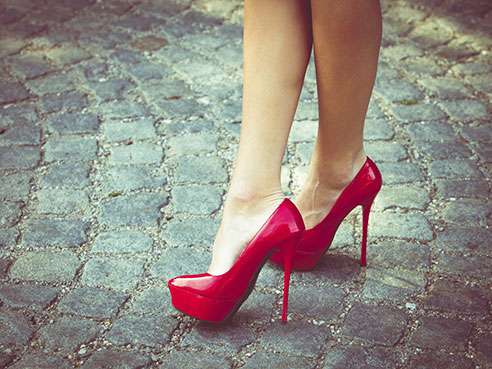Study shows that injury rates from wearing high-heeled shoes have doubled

Americans love high-heeled shoes. One survey in 2003 reported that 62 percent of American women wore shoes with a 2-inch or greater heel on a regular basis. Those shoes are taking a toll.
New research from the University of Alabama at Birmingham shows that high-heeled-shoe-related injuries doubled between 2002 and 2012. The findings were published online May 12 in the Journal of Foot and Ankle Injuries, and the frequency and severity of those injuries were sufficient to make the investigators suggest that wearing the appropriate shoes for the appropriate occasion and being aware of one's surroundings are good ideas.
"Although high-heeled shoes might be stylish, from a health standpoint, it would be worthwhile for those interested in wearing high-heeled shoes to understand the risks and the potential harm that precarious activities in high-heeled shoes can cause," said lead investigator Gerald McGwin, Ph.D., vice chair and professor of the Department of Epidemiology in the UAB School of Public Health.
In addition to discomfort in the lower leg, ankle and foot, research has indicated that walking in high-heeled shoes has been shown to significantly reduce ankle muscle movement, step length, total range of movement and balance control. Many studies have documented that the long-term use of high heels alters the neuromechanics of walking and places greater strain on the muscles and tendons of the lower legs, which can lead to musculoskeletal disorders later in life.
McGwin's team looked at data from the Consumer Product Safety Commission's National Electronic Injury Surveillance System of injuries associated with wearing high heels seen in hospital emergency departments between 2002 and 2012. There were 123,355 high-heel-related injuries seen during that period. The peak year for injuries was 2011, with more than 19,000. People between the ages of 20 and 29 were most likely to suffer an injury, followed by the 30-39 age group.
"Some historians suggest that high-heeled shoes have been around for nearly 300 years, and that medical professionals have been warning wearers about the dangers of such shoes for the same amount of time," McGwin said. "While previous studies have confirmed that high heels are associated with lower extremity discomfort and musculoskeletal issues, there is very little information on the nature and frequency of these injuries, or which age groups were most affected."
The vast majority of the injuries—more than 80 percent—were to the ankle or foot, with just under 20 percent involving the knee, trunk, shoulder, or head and neck. More than half were strains or sprains, with fractures accounting for 19 percent of all injuries. While white females as a group had the largest number of heel-related injuries, the rate of injury for black females was twice that of whites.
"Our findings also suggest that high-heel-related injuries have increased over time, with the rate of injury nearly doubling from 2002 to 2012," McGwin said. "We also noted that nearly half the injuries occurred in the home, which really supports the idea of wearing the right footwear for the right occasion and setting. Also, to reduce the time of exposure, we recommend that those wearing heels be aware of how often and for how long they wear them."
More information: "Epidemiology of High-Heel Shoe Injuries in U.S. Women: 2002 to 2012." DOI: dx.doi.org/10.1053/j.jfas.2015.04.008


















